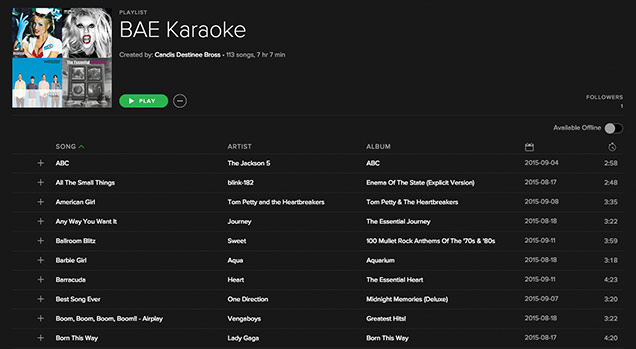Bobbyisms: Music playlists
 CREDIT: SPOTIFY APP
CREDIT: SPOTIFY APPIn the rise of a digital streaming society, the art of making a mixed tape either for a friend or for a long drive has been lost, replaced by liking, following, subscribing, etc., in order to hear your favourite artists.
From art form to platform
I write about random things a lot. I write a lot about random things. It was a handful of Octobers ago that my first column ran in Interrobang and in it I offered tips to improve upon personal playlists, a few suggestions in the hope that one’s mixtape might be a more dynamic listen.
I still agree with what I wrote, that mixes should blend all manner of musical flavours and they are most effective when they’re kept short and sweet. I still feel the same about playlisting, but the reality is that I still have a romantic view of the art form in a world of digital platforms that use playlisting as a marketing tool. I’m doing it wrong and if you don’t know the difference between the two you may be doing it wrong, too.
The Rob Gordons of the world will ensure that good mixtapes will always prevail, but people don’t consume music in quite the same way now as they did in 2000. Everyone’s home computer had a disc burner in it by the time the world got accustomed to file sharing, people burned a lot of mixes for their friends and their cars.
But the rise in digital streaming subscriptions and growing trend of tablet–style computers without disc drives, fewer people than ever are sculpting and burning mixes and instead using playlists for their new primary purpose: followers.
The Recording Industry Association of America (RIAA) recently published their mid–year report on U.S. music sales and revenues. During the first half of 2015, vinyl music sales earned more in the U.S. than ad–supported streaming services, including YouTube, Vevo, and Spotify with earnings totaling over $162 million, streaming revenue has claimed its place with physical and digital music sales as a viable source of income.
But that’s not all. Streaming revenue accounted for 32 per cent of the industry total — having passed physical music sales in earnings at 24 per cent — and stands only to gain on the sales of permanent downloads at 40 per cent through platforms like iTunes or Google Play.
Each of these online music platforms have their pros and cons when it comes to discovering and sharing music, but one thing they all have in common is how they use playlists. One discovers the playlist and clicks to subscribe, follow or favourite it to be notified when its content is next updated.
In this way, the individuals or outlets creating the playlists build an audience of followers that are notified whenever a given list is updated with new music. And while the concept of frequently refreshing a playlist contrasts against the old art of sculpting mixes for expression, it has valuable marketing potential.
Great news for indie artists though is even without a large subscriber base, you can garner a lot of views for your music by featuring it in playlists alongside popular songs.
But the time and effort required to maintain exposure is considerable, you have to be either the one to create many playlists with your music placed throughout, or desirable enough to attract others to include you in their playlists.
It’s a full time job in and of itself, so be mindful of whether you want to spend the time on the music or the promotion and aim for a balance that works for you.
For more information on the 2015 Mid–Year RIAA Shipment and Revenue Statistics report, visit their website at riaa.com. The paper is posted in its entirety in PDF and paints an interesting picture of what RIAA Chairman and CEO Cary Sherman calls, “a business undergoing an enormous transition”.
And for more of the latest music news, recommendations and gigs in London, follow @fsu_bobbyisms on Twitter. Visit fsu.ca for a list of events happening right here on campus, please support local music. I’m out of words.














